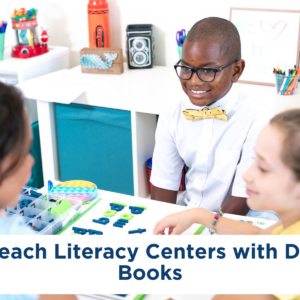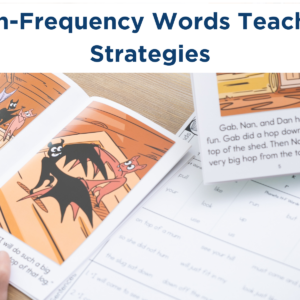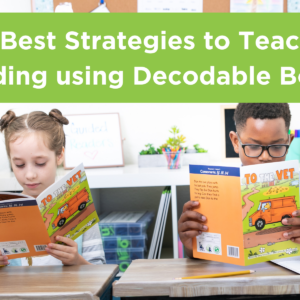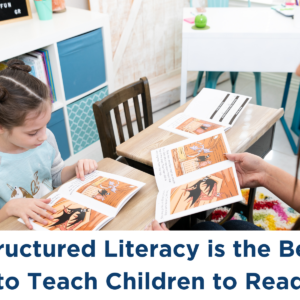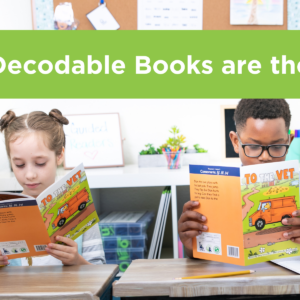Are leveled readers or decodable books better for reading instruction? As a primary teacher for 23 years, I used leveled readers in my classroom and truly believed that I was doing the best for my students. However, eventually, I dug into the research about the Science of Reading and realized that leveled readers weren’t the best way to teach children to read.
Educators and researchers are now saying that leveled readers are “harmful” for children. I don’t agree with this statement 100%, but I do believe that decodable books are best for reading instruction and I’ll share five reasons why below.
Are Leveled Readers Harmful to Children Learning to Read?
I believe leveled readers should only be used with students once they have mastered the English code. This means they know and can decode the 44 sounds of the English language and the graphemes associated with those phonemes. That’s when I believe all books can be brought in to foster a love and enjoyment for reading. But decodable books must be used in the beginning between kindergarten and first grade to build the foundation.
As a second-grade teacher for 23 years, things were a little different in my classroom. At the start of the year, there were tremendous differences in the reading abilities of students. Some came in reading at a Kindergarten or first-grade level, and others at a fourth or fifth-grade level.
I used leveled readers and decodable readers in my classroom years ago, but knowing what I know now about the research and what’s happening in the brain when a child learns to read, I would only use decodable books with students learning to read. Once students have mastered the 44 sounds of the English language and the graphemes that represent the sounds, it’s game on. You can use all the books in your classroom library.
Five Reasons Why Leveled Readers Aren’t the Best Way to Teach Children to Read
Again, let me start by saying that I don’t believe leveled books are the worst thing in the world. But I don’t believe they should be used as “leveled” books. Instead, they should be used to gather information, enjoy illustrations, learn a lesson, and understand the theme of the story.
Here are five reasons why leveled readers shouldn’t be used when teaching children to read.
1. Leveled Readers are Misaligned with the Science of Reading
 Leveled readers don’t align with the Science of Reading or what’s happening in the brain of a child learning to read. They often emphasize memorization and guessing based on pictures and context clues from the story. Many leveled readers have a heavy focus on predictive text. This contradicts the Science of Reading which focuses on the importance of phonemic awareness and phonics for decoding words.
Leveled readers don’t align with the Science of Reading or what’s happening in the brain of a child learning to read. They often emphasize memorization and guessing based on pictures and context clues from the story. Many leveled readers have a heavy focus on predictive text. This contradicts the Science of Reading which focuses on the importance of phonemic awareness and phonics for decoding words.
Here are some text examples from the leveled reader Do You See?
- “Do you see my book?”
- Do you see my cat?
- Do you see my dog?
The words “do you see” repeat over and over throughout the book. We need to ensure children are not reading predictive texts like “do you see” from this book. Even though they are using sight words, the students learn them on the first page and then simply repeat them on each page after. They’re not really reading those words; they’re just memorizing the predictive nature of the text.
In addition, other words in the book, such as “cat,” “dog,” and “truck,” aren’t words typical Kindergarten students have learned the skills to read at the beginning of the year. The only way children in kindergarten know what those words are on the page is by looking at the picture cues. They’re not learning to read the words on the page.
The Decodable Book Difference
 In contrast, decodable books, are focused on reading. They’re based on phonics and using systematic phonics instruction. So, if a student is reading a decodable book, it includes the sounds they’re focused on learning and have already been explicitly taught.
In contrast, decodable books, are focused on reading. They’re based on phonics and using systematic phonics instruction. So, if a student is reading a decodable book, it includes the sounds they’re focused on learning and have already been explicitly taught.
A decodable book follows an explicit scope and sequence. Children are not expected to read words they haven’t learned yet. For example, in the decodable book Bad Max, students see only short vowel words. Decodable books don’t introduce difficult, more high-level skills until they’re explicitly taught in a scope and sequence.
2. Leveled Readers Have an Inadequate Focus on Phonics and Decoding
While this point is similar to what we discussed above, it’s important. Let’s look at the example of the leveled reader Barnyard Mystery. 
- “Ben is a farmer. Ben lost his hat. Ben lost his ball.”
- “Where did they go? Ben looks.”
- “Are they with the pigs? No.”
- “Are they with the goat? No.”
The book is too complex for beginning readers. It has repetitive patterns similar to the predictive text from Do You See instead of teaching the essential skills of phonics and decoding.
This can leave gaps in a child’s ability to decode unfamiliar words. While the book is beautifully illustrated, it was intended for Kindergarteners beginning to read. But there are multiple words in this book that kindergarten students haven’t learned the sounds for yet. It’s too complex for them to read without the picture support.
That’s the difference between a decodable book and a leveled reader. Decodable books introduce phonics patterns gradually and systematically, allowing students to practice decoding skills with every new letter sound relationship they’re taught. This builds a solid foundation for reading so they don’t have to rely on the pictures.
The Decodable Book Difference
 Let’s look at the decodable book Bad Max again. Remember, when students begin reading this book, they’ve already learned the 26 sounds of the alphabet and are focused solely on the short “a” sound along with some specific high-frequency words used in the text.
Let’s look at the decodable book Bad Max again. Remember, when students begin reading this book, they’ve already learned the 26 sounds of the alphabet and are focused solely on the short “a” sound along with some specific high-frequency words used in the text.
Here is some of the text from the book:
- “Bad Max!” yaps my dad. The lad is mad at Max. He nabs the rag.”
- “Bad Max!” yaps the lad. I am mad at Max. Max sat on the hat.”
- “Bad Max!” I yap. Tad is mad at Max. Max is on the mat.”
On each page of this book, you can see the short vowel sounds along with those high-frequency words. That’s the difference. You don’t see long vowels, VCE patterns, or digraphs used in the book because students haven’t learned them yet.
The book only uses short vowel words and high-frequency words that students have learned through phoneme-grapheme mapping. Students are explicitly taught those words because they need to have a nice bank of high-frequency words in order to read a book.
The book only uses short vowel words and high-frequency words that students have learned through phoneme-grapheme mapping. Students are explicitly taught those words because they need to have a nice bank of high-frequency words in order to read a book.
3. Leveled Texts Have a Dependence on Contextual Guessing
Looking back at the book Barnyard Mystery, kindergarten students have to use pictures to read words like “pigs,” “cow,” “horse,” and “goat.” These aren’t sounds that early kindergarten students have learned yet. Instead, they’re forced to use contextual guessing, such as context from the picture or the sentence.
Using picture cues is a big part of teaching with leveled readers. Students must focus on using the pictures to determine the unknown words, and we don’t want to promote the habit of using pictures and contextual guessing in order to read. Instead, we want them to decode the words on the page by sounding out the words.
The Decodable Book Difference
Of course, students can always use the pictures in decodable books to help them read the words as well. But the difference is students are being explicitly taught to focus on the words and letters when reading a decodable book. You’re pointing the words out to your students and having them put their fingers under them to really focus as they read.
We want to constantly prompt students by asking them what the first letter says or what sound it makes and help them start to sound out the rest of the word. We want them to focus on decoding and feeling confident that they’re reading the words on the page, not guessing.
4. Leveled Readers Promote a Lack of Confidence
Leveled readers can create real frustration in early readers by using words they haven’t been taught how to read. Let’s look at the leveled reader Helping with the Laundry. Here are a few examples from the book:
- “Do you help at home?”
- “You can. You can help with the laundry.”
- “Sort the clothes.”
Introducing this book to a kindergartener can create a lack of confidence and frustration, especially if the pictures are covered in the book. The words included in this book aren’t what a typical kindergarten reader would know without the help of pictures on the page.
There are some high-frequency words like “you” and “can” but it also includes “laundry.” This is a multisyllabic word that students wouldn’t know how to read.
The Decodable Book Difference
In contrast, decodable books provide a sense of achievement for early readers. Students can successfully decode the words they’re seeing on the page because they’ve been taught the necessary skillset.
Decodable books foster a positive relationship with reading because they help students build their confidence and feel successful. This is another reason they should be used by kindergarteners and first graders.
In addition, if you teach second graders, you should assess them at the beginning of the year to identify any gaps in their learning. Then, you can attack those gaps by explicitly and systematically teaching students the phonetic sounds and phonemes. We need to focus on building a strong K-2 foundation.
5. Leveled Readers Create Slow Reading Fluency Progress
We now understand what’s going on in the brain when children are learning to read, so we need to use that science and research in our classroom instruction. Again, knowing what I know now, I wish I could go back and ensure I was following an explicit and systematic scope and sequence with my students. But we can follow the “know better, do better” philosophy.
Leveled readers create slow progress in reading fluency, and now that we know that, we can make necessary changes to do better for our students.
The Decodable Book Difference
 Decodable books ensure children build their reading skills systematically, which allows them to develop fluency and comprehension faster. It may seem slower in the beginning, but by the end, it feels very fast. The goal of decodable books is that as students become more adept at decoding, they’re able to tackle more complex text with ease.
Decodable books ensure children build their reading skills systematically, which allows them to develop fluency and comprehension faster. It may seem slower in the beginning, but by the end, it feels very fast. The goal of decodable books is that as students become more adept at decoding, they’re able to tackle more complex text with ease.
Let’s look at the example of the decodable book The Black Flash. This book is used when teaching digraphs. When students use this book, they’ve already systematically learned all the short vowel sounds and are being taught digraphs. That means the book uses short vowels, high-frequency words, and digraphs. Here are a few examples from the text:
- “Tom sits in his shop. He sits with his pal Chad.”
- “The pals chat in the back of the shop.”
- “Tom sees a black flash! Then Chad sees a black flash!”
While there are some more complex words in this book, the difference is that students were explicitly and systematically taught short vowels and all the consonant sounds and are now focused on digraphs.
Ready to Try Decodable Books in the Classroom?
I hope this helps you gain a greater understanding of why decodable books are the gold standard for teaching children to read. It’s so important to use systematic phonics instruction with books aligned to the scope and sequence.
It’s not about what books are the best on the market; it’s about which decodable books align with your scope and sequence.
I have 16 decodable books you can download and try for free! Our Developing Decoders books align with UFLI’s explicit and systematic scope and sequence. So these are a great way to try decodable readers in your classroom or get new aligned books for your students if you’re already following the UFLI scope and sequence.
Now that we know so much about the brain and how the brain learns to read, I hope this has encouraged you to try using decodables in your classroom instruction to start moving toward a structured literacy approach.


